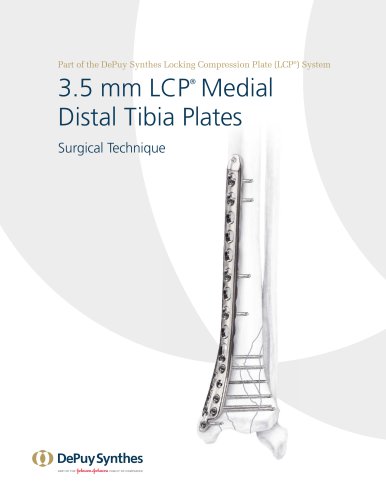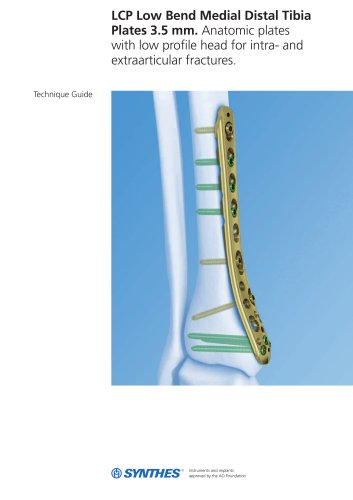
Catalog excerpts
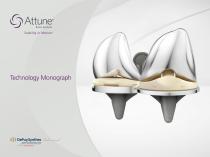
Technology Monograph
Open the catalog to page 1
ATTUNE GRADIUSTM Curve SOFCAMTM Contact LOGICLOCKTM Tibial Base GLIDERIGHTTM Articulation INTUITIONTM Instruments CONTENTS Introduction Development Process LOGICLOCK TM TIBIAL BASE The LOGICLOCKTM Tibial Base has a patented central locking design that provides the architecture for the system that optimizes kinematics, while reducing backside micromotion to the lowest reported levels in the industry. Patient Fit for Stability AOXTM Polyethylene Cruciate Sacrificing Wear Resistance
Open the catalog to page 2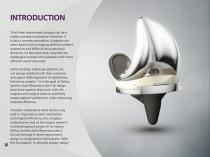
INTRODUCTION Total knee replacement surgery can be a highly successful procedure. However, it is also a complex procedure. Surgeons are often faced with managing different patient anatomies and difficult intra-operative decisions. At the same time, hospitals are challenged to treat more patients with more efficient use of resources. Unfortunately, total knee patients are not always satisfied with their outcome and report differing levels of satisfaction following surgery.1,2 It is the goal of DePuy Synthes Joint Reconstruction* to design total knee systems that work with the surgeon and...
Open the catalog to page 3
DEVELOPMENT PROCESS The ATTUNE® Knee System represents one of the largest research and development projects in the history of DePuy Synthes Joint Reconstruction. Studies of total knee patients revealed that patients are not always satisfied with their outcome and report differing levels of satisfaction following surgery.1,2 As a result, improving implant performance and patient satisfaction was the focus of the ATTUNE Knee project from the beginning. At the same time, the demand for joint arthroplasties and increase in hospital costs is causing a significant economic burden to society. In...
Open the catalog to page 4
Patient Need VIEW GRAPH The ATTUNE Knee started with a patient need. While total knee replacement surgery can be a highly successful procedure, in some cases, patients report dissatisfaction or the implant fails prematurely. According to Baker et.al., approximately 10-20% of total knee patients are not satisfied with their knee replacement.2 While many hip replacement patients mention their “forgotten hip,” many knee replacement patients are reminded every day of their replaced knee. Certain functional activities, such as walking up and down stairs or bending down to greet their...
Open the catalog to page 5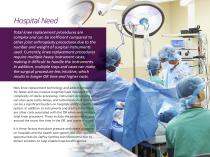
Hospital Need Total knee replacement procedures are complex and can be inefficient compared to other joint arthroplasty procedures due to the number and weight of surgical instruments used. Currently, knee replacement procedures require multiple heavy instrument cases, making it difficult to handle the instruments. In addition, multiple trays and cases can make the surgical procedure less intuitive, which results in longer OR time and higher costs. New knee replacement technology and added demands for faster and less invasive surgeries have increased the complexity of sterile processing....
Open the catalog to page 6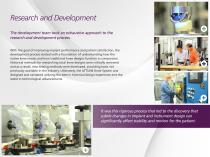
Research and Development The development team took an exhaustive approach to the research and development process. With the goal of improving implant performance and patient satisfaction, the development process started with a foundation of understanding how the native knee moves and how traditional knee designs function in comparison. Historical methods for researching total knee designs were critically reviewed and as a result, new testing methods were developed, providing tools not previously available in the industry. Ultimately, the ATTUNE Knee System was designed and validated...
Open the catalog to page 7
Surgeon Design Team The surgeon design team represents key experts from seven countries around the world. This diverse team has varying philosophies with regards to PCL management, implant fixation, bearing preferences, and surgical technique. This vastly experienced team provided the diversity needed to create a knee system to accommodate surgeons and patients around the world. The surgeon design team was assembled into four sub-teams to assist in the design and development of the many different aspects of the ATTUNE Knee System. Each surgeon provided valuable insight and guidance within...
Open the catalog to page 8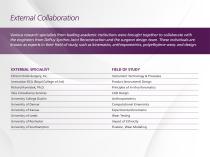
External Collaboration Various research specialists from leading academic institutions were brought together to collaborate with the engineers from DePuy Synthes Joint Reconstruction and the surgeon design team. These individuals are known as experts in their field of study, such as kinematics, anthropometrics, polyethylene wear, and design. EXTERNAL SPECIALIST Instrument Technology & Processes Innovation RCA (Royal College of Art) Product (Instrument) Design Principles of In-Vivo Kinematics Tata Consultancy Services University College Dublin Computational Kinematics Experimental Kinematics...
Open the catalog to page 9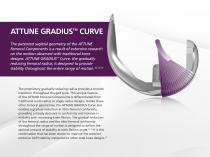
ATTUNE GRADIUS CURVE TM The patented sagittal geometry of the ATTUNE Femoral Components is a result of extensive research on the motion observed with traditional knee designs. ATTUNE GRADIUS™ Curve, the gradually reducing femoral radius, is designed to provide stability throughout the entire range of motion.12,13,14 The proprietary gradually reducing radius provides a smooth transition throughout the gait cycle. This unique feature of the ATTUNE Femoral Components is differentiated from traditional multi-radius or single radius designs. Unlike these other femoral geometries, the ATTUNE...
Open the catalog to page 10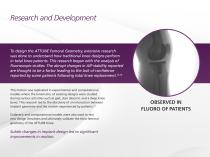
To design the ATTUNE Femoral Geometry, extensive research was done to understand how traditional knee designs perform in total knee patients. This research began with the analysis of fluoroscopic studies. The abrupt changes in A/P stability reported are thought to be a factor leading to the lack of confidence reported by some patients following total knee replacement.15,16 This motion was replicated in experimental and computational models where the kinematics of existing designs were studied during various activities such as gait, stair descent, and a deep knee bend. This research led to...
Open the catalog to page 11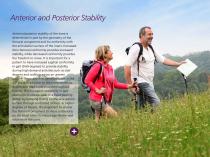
Anterior and Posterior Stability Anterior/posterior stability of the knee is determined in part by the geometry of the femoral component and its conformity with the articulation surface of the insert. Increased tibio-femoral conformity provides increased stability, while decreased conformity provides the freedom to move. It is important for a patient to have increased sagittal conformity in gait (0-60 degrees) to provide stability during high demand activities such as stair descent and walking across an uneven surface. These activities generate loads in the A/P plane in addition to the...
Open the catalog to page 12All Depuy Synthes catalogs and technical brochures
-
2.0 mm LCP® Distal Ulna Plate
20 Pages
-
Building on Success
16 Pages
-
RADIUS OF CURVATURE
3 Pages
-
Introducing The Variable Angle
12 Pages
-
HEALIX Anchor™ 3.4 mm
2 Pages
-
Small Battery Drive II
4 Pages
-
HEALIX ADVANCE
4 Pages
-
3.5 mm LCP™ Medial
15 Pages
-
Titanium Sternal Fixation System
34 Pages
-
MatrixRIB®FixationSystem
86 Pages
Archived catalogs
-
2.4 mm VA LCP™
4 Pages
-
Mandible Trauma Solutions
2 Pages
-
Power line II
4 Pages
-
Concorde
28 Pages
-
LCP Intercarpal
31 Pages
-
LCS® COMPLETE™
2 Pages
-
Synthes TPLO.
8 Pages
-
SynFix-LR System
56 Pages
-
ATB Anterior Tension Band Plate
32 Pages
-
CONDUIT™
15 Pages
-
Brochure_FINAL
2 Pages
-
DePuy Synthes
81 Pages
-
Anspach
3 Pages
-
Orthopedic Foot Instruments
32 Pages
-
PINNACLE® Hip Solutions
12 Pages
-
Corail
24 Pages
-
S-ROM® NOILES™
68 Pages
-
TRI-LOCK® Product Rationale
12 Pages
-
Reclaim Surgical Technique
44 Pages
-
Speed
2 Pages
-
HAMMERLOCK® 2
2 Pages
-
DePuy Glenoid Solutions
2 Pages
-
Trauma Solutions. Elbow
4 Pages
-
Polar
4 Pages
-
Alveolar Distractor.
4 Pages
-
Piezoelectric System
4 Pages
-
Air Power Line II
6 Pages
-
LCP Clavicle Hook Plate
4 Pages
-
TruMatch Pin Guides
16 Pages
-
P F N A
8 Pages
-
SKILL, DEDICATION,
16 Pages
-
Orthopaedics. Overview
20 Pages
-
DURALOC
16 Pages
-
Marathon Cemented Cup
20 Pages
-
REEF Surgical Technique
16 Pages
-
MatrixNEURO
8 Pages
-
Anspach XMax
4 Pages
-
Anspach eMax 2 Plus
4 Pages
-
Small Electric Drive
4 Pages
-
Air Pen Drive
4 Pages
-
Colibri II
4 Pages
-
Spine
25 Pages
-
Expert Hindfoot Arthrodesis Nail
48 Pages
-
LCP Distal Fibula Plates
32 Pages
-
TomoFix
60 Pages
-
Expert Tibial Nail PROtect
16 Pages
-
Expert Tibia Nail
84 Pages
-
Sacral Bars
16 Pages
-
Pelvic C-Clamp
20 Pages
-
Low Profile Pelvic System
16 Pages
-
Proximal Femoral (Hook) Plate
24 Pages
-
LCP
24 Pages
-
PFNA
112 Pages
-
HCS 1.5, 2.4, 3.0
36 Pages
-
LCP Wrist Fusion
32 Pages
-
LCP Compact Hand
28 Pages
-
VA-LCP Elbow
48 Pages
-
Distal Radius
44 Pages
-
Olecranon
30 Pages
-
LCP Hook Plate
28 Pages
-
DHP & Olecranon
4 Pages
-
LCP S-A
4 Pages
-
Epoca
4 Pages
-
Philos
32 Pages
-
MultiLoc
68 Pages










